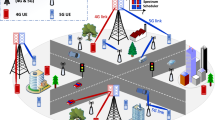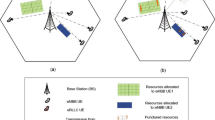Abstract
QoS provisioning and high capacity for high mobility users are considered as the distresses of broadband wireless communications (BWC) and specifically the key technology of WiMAX. Hence, the scheduling and resource allocation algorithms play the main role in this regard. In the research conducted on scheduling algorithms in WiMAX network, two principal methods of AMC and PUSC are used. The high capacity in AMC mode algorithms is achieved by considering the low speed users. Conversely, in PUSC mode algorithms, speed does not affect the network performances; however, the capacity is low. To date, the importance of presenting QoS and maintaining the network capacity for the users with different speeds has not been acknowledged yet. This paper presents novel scheduling algorithms and also new frame partitioning scheme which are proper for the users with different mobility speeds. The new algorithm uses two modes of AMC and PUSC simultaneously to maintain the high capacity of the network. QoS is also provided. The simulation results reveal that our algorithm increases capacity while it presents low packet delay and packet loss rate in the presence of both high and low mobility speed users.














Similar content being viewed by others
References
Rath, H. K., Bhorkar, A., & Sharma, V. (2006, November). An opportunistic uplink scheduling scheme to achieve bandwidth fairness and delay for multiclass traffic in WiMax (IEEE 802.16) broadband wireless networks. In Proceedings of IEEE global telecommunications conference (pp. 1–5).
Liu, O., Wang, X., & Giannakis, G. B., (2005, August). Cross-layer scheduler design with QoS support for wireless access networks. In Proceedings of international conference on quality of service in heterogeneous wired/wireless, networks (pp. 13–21).
Zhul, X., Huo, J., Zhaol, S., Zeng, Z., & Ding, W. (2008). An adaptive resource allocation scheme in OFDMA based multiservice WiMAX systemis. In Proceeding of the 10th IEEE international on advanced, communication technology (ICACT) (Vol. 1, pp. 593–597).
Kaneko, M., & Popovski, P. (2007). Adaptive resource allocation in cellular OFDMA system with multiple relay stations. In IEEE 65th VTC (pp. 3026–3030).
Ali Yahiya, T., Beylot, A. L., & Pujolle, G. (2008). Channel aware scheduling for multiple service flows in OFDMA based mobile WiMAX systems. In Proceeding of the 68th IEEE conference on vehicular technology (VTC) (pp. 1–5).
Jianfeng, S., Jiandong, L., & Changle, L. (2009). A cross-layer WiMAX scheduling algorithm based on genetic algorithm. In Communication networks and services research conference (pp. 292–296).
Rapaport, T. (2002). Wireless communications principle and practice, 2nd ed. USA: Bernad M. Goodwin.
Chang, C. J., Yen, C. M., Ren, F. C., & Chuang, C. H. (2008). QoS_GTE: A centralized QoS guaranteed throughput enhancement scheduling scheme for relay-assisted WiMAX networks. In Proceedings of IEEE international conference on communications (ICC) (pp. 3863–3867).
Zeng, H., & Zhu, C. (2009). Resource allocation in 802.16j multi-hop relay systems with the user resource fairness constraint. In WCNC’09 IEEE conference.
Lin, S. J., & Sheen, W. H., (2008, February 29). Resource scheduling with directional antennas for multi-hop relay networks in manhattan-like environment.
Riato, N., Sorrentino, S., Franco, D., Masseroni, C., Rastelli, M., & Trivisonno, R. (2007). Impact of mobility on physical and MAC layer algorithms performance in WiMAX system. In Proceeding of the 61st IEEE international symposium on personal, indoor and mobile radio, communications (pp. 1–6).
Mills, A., Lister, D., De Vos, M., & Ji, Y. (2010). The impact of MS velocity on the performanc of frequency selective scheduling in IEEE 802.16e mobile WiMAX. In Proceeding of the 7th IEEE conference on consume communications and networking (CCNC) (pp. 1–5).
IEEE 802.16j-2007. Draft IEEE standard for local and metropolitan area networks—Part 16: Air interface for fix and mobile broadband wireless access systems.
Adas, A. M. (1998). Using adaptive linear prediction to support real-time VBR video under RCBR network service model. IEEE/ACM Transactions on Networking, 6(5), 635–644.
WiMAX Forum Mobile System Profile 4 Release 1.0 Approved Specification, Wimax, Forum, May 2007.
Baum, D. S., Hansen, J., Salo, J., & Galdo, J. (2005). An interim channel model for beyond-3G systems: Extending the 3GPP spatial channel model (SCM). In Proceeding of the 61st IEEE international conference on vehicular technology (Vol. 5, pp. 3132–3136).
Wang, L. C., Su, W. S., Huang, J. H., Chen, A., & Chang, J. H. (2008). Optimal relay location in multi-hop cellular systems. In Proceedings of IEEE conference wireless communications and networking (WCNC) (pp. 1306–1310).
Common HSDPA system simulation assumptions 3GPP TSG RAN WG, 1 August (2000). Ericsson, Nokia, Motorola.
Cdma 2000 Evaluation Methodology, 3GPP2 Contribution C.R1002-0, vI.0, December 10, 2004. In IEEE conference on consume communications and networking (CCNC) (pp. 1–5) (2010)
Kim, J., Kim, E., & Kim, K. S. (2006). A new efficient BS scheduler and scheduling algorithm in WiBro systems. In Proceedings of ICACT (Vol. 3, pp. 1467–1470).
Hui, T., Xuelin, G., & Ping, Z. (2005). The impact of relaying strategies on the performance in cellular system. In Proceedings of ISCIT (pp. 1357–1360).
Sreng, V., Yanikomeroglu, H., & Falconer, D. D. (2003). Relayed selection strategies in cellular networks with peer-to-peer relaying. In Proceedings of IEEE VTC fall (pp. 1949–1953).
Author information
Authors and Affiliations
Corresponding author
Rights and permissions
About this article
Cite this article
Gholipur, T., Mahdavi, M. & Zeidaabadi Nezhad, A. A Novel Scheduling Algorithm for Low and High Mobility Users in Multi-hop WiMAX Network. Wireless Pers Commun 72, 1203–1228 (2013). https://doi.org/10.1007/s11277-013-1074-3
Published:
Issue Date:
DOI: https://doi.org/10.1007/s11277-013-1074-3




